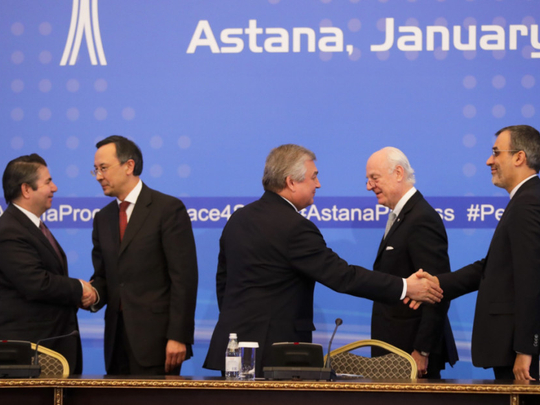
Despite major violations to the ceasefire in Syria, uncertainty about the policies of the new United States administration, and Iran’s subversive role, Russia continues seemingly undeterred with its plan to resolve the Syrian crisis. Moscow succeeded in taking the first step of getting the armed Syrian opposition factions and the regime of President Bashar Al Assad to meet in Astana — Kazakhstan — last month. It succeeded also in getting Iran to agree on a mechanism to make all parties respect the ceasefire. Given its passionate efforts to eliminate the Syrian opposition, guaranteeing Iran’s support for the ceasefire agreement was a painful task. Indeed, restraining the fanatic pro-Iran militias proved to be much more difficult than Moscow had initially believed. So far, they remain the major violators of the Ankara ceasefire agreement since it came into effect on December 30, 2016.
Indeed, Russia needed first to overcome Iran’s opposition to the Aleppo agreement, which gave access to the besieged opposition factions to evacuate the city with their light weapons. Moscow managed also to soften Iran’s opposition to the representation of armed groups in the Ankara ceasefire agreement, who it considers terrorist groups. The final obstacle the Russian had to deal with was Iran’s opposition to any role by the US in the Astana meeting. Moscow overcame that by extending an invitation to the Trump administration, which attended the meeting albeit on the level of its ambassador to Kazakhstan.
The meeting was supposed to focus almost entirely on the consolidation of the ceasefire agreement, as a key step towards resuming the peace talks in Geneva. Russia, however, took almost everyone off guard by producing a draft constitution for Syria, which, from Moscow’s perspective, would pave the way to resolving the six-year old Syrian conflict. This step was largely interpreted as an attempt by Russia to reach a resolution outside the Geneva framework and within the trilateral context that emerged at Astana (Turkey-Russia-Iran). Some of the proposed constitutional provisions reveal Russia’s endeavour to win over a part of the opposition — the armed factions in particular — by weakening the position of the Presidency of the Republic as an avenue towards a solution. Article 44 of the draft constitution stipulated that the Representative Assembly (parliament) has the power to terminate the mandate of the President; appointment of the judges of the Supreme Constitutional Court; and appointment and dismissal of the chairman of Syria’s Central Bank. The draft also restricts the role of the army to defend the nation from external threats. Paragraph 4 of Article 10 provided that the army and other armed forces shall be under public oversight and shall defend Syria and its territorial integrity; they may not be used as an instrument of suppression of the people; they may not interfere in politics or participate in the transfer of power.
The opposition refused to discuss the draft document on the basis that drawing up a constitution was a matter for the Syrian people and should be the result of the political process, not a precursor to it. The regime, which has always been highly sensitive regarding matters of sovereignty, made no public comment on the Russian proposal.
While the role of Russia in the Syrian conflict was growing, the role of the US was diminishing; manifest in its low-level representation at Astana. The US was content to be present as an observer, while Russia, together with United Nations envoy Steffan De Mistura, took on the lead role in mediating between the Syrian parties to the conflict. The US absence did not last long, however. In his first week as President, Donald Trump proposed the establishment of safe zones inside Syria, based on the assumption that this would provide a solution to the refugees’ question. Trump asked the Pentagon and the US State Department to present him with a plan to create safe zones inside Syria within 90 days. The Russians could not conceal their displeasure at this proposal, which interferes with their efforts to solve the Syrian conflict.
Astana may prove to be an important step in the long path towards peace in Syria. Russia seems to be more concerned than ever to bring about a solution to the Syrian conflict. Yet, many obstacles remain in place. Foremost among them is the role of Iran and its allies who still hold the belief that a military victory is still possible in Syria. The effect of other factors is yet to become clear. These include the position the Trump administration will adopt and the outcome of the schism between the different Syrian opposition factions.
Dr Marwan Kabalan is a Syrian academic and writer.








